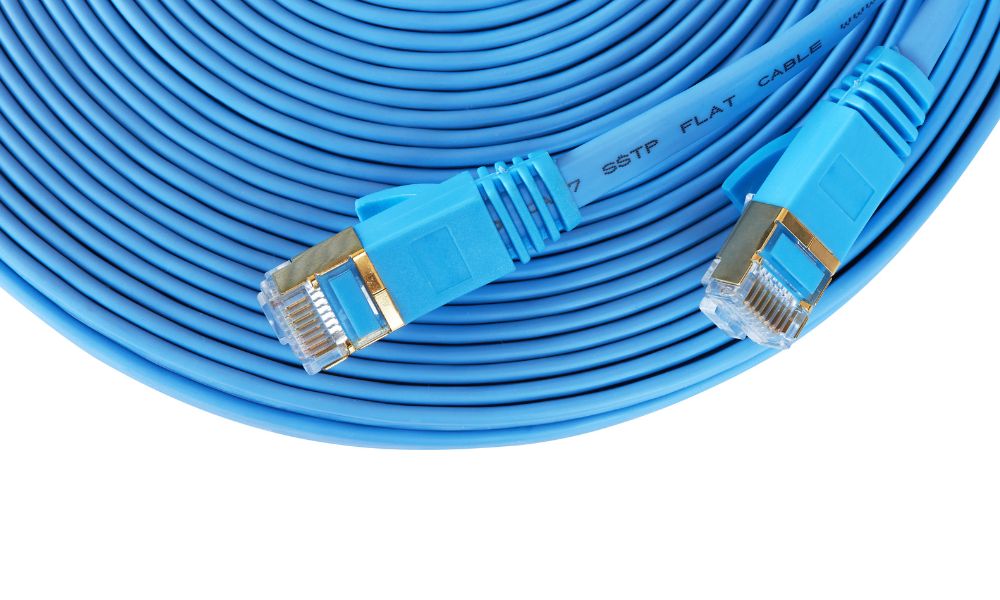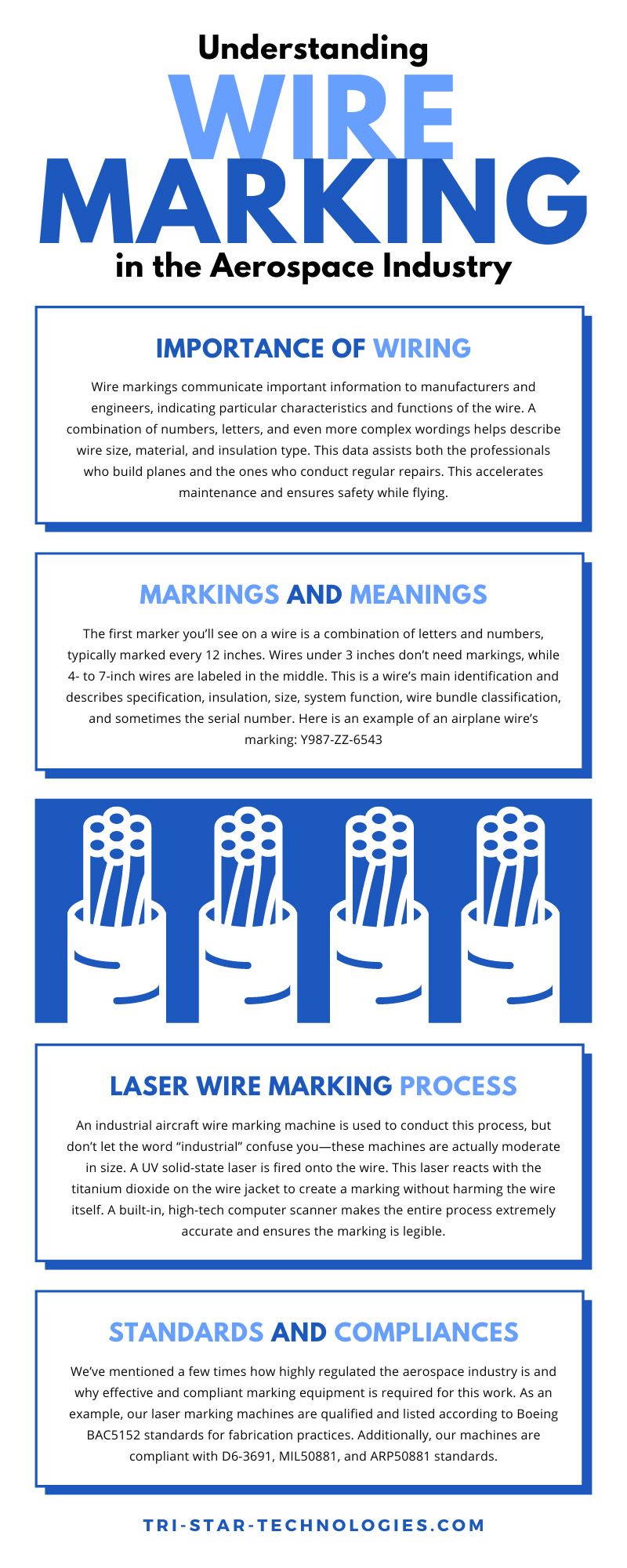Understanding Wire Marking in the Aerospace Industry

Think about the complexity of modern aircraft. They’re capable of comprehensive auto piloting, can soar through the air for hundreds of miles without engine power, are safer than they’ve ever been, and feature comfort features like in-flight Wi-Fi capabilities. These features and many more are all possible thanks to the many hours spent designing, constructing, and maintaining the aircraft by very intelligent professionals.
With advancements in modern technology, machines are also used to help conduct precise processes to make the lives of engineers and manufacturers easier. One tiny aspect of the aerospace industry is wire marking. With laser marking machines, you can accurately label wires and bundles with information that clearly identifies wire function, size, material, and the overall specification. Understanding the importance of this process is essential for all individuals working in this field. Here is a general overview of laser markers, why they’re so important, and how this process is possible.
Importance of Wiring
It’s no secret that airplanes consist of many components—modern commercial aircraft feature over a million parts alone! Of those millions of objects, you’ll find almost 1,000 wire bundles (standard on 747s), with each bundle containing hundreds of wires. Think about the diverse responsibilities of each and every wire. Some control the massive engines, some raise and lower flaps and wheels, and others might simply supply power to an individual seat. Due to the sheer variety and number of wires, it’s no wonder that wire marking is essential within the industry.
Wire markings communicate important information to manufacturers and engineers, indicating particular characteristics and functions of the wire. A combination of numbers, letters, and even more complex wordings helps describe wire size, material, and insulation type. This data assists both the professionals who build planes and the ones who conduct regular repairs. This accelerates maintenance and ensures safety while flying.
Various regulatory organizations and departments, such as the Federal Aviation Administration, US Departments of Transportation, and the International Air Transport Association, all demand perfection with every plane that Boeing, Air Bus, or any other manufacturer releases to the public. Small things like wire marking are one reason that flying has never been safer in human history. If a person flew on a commercial jet every single day for over 10,000 years, they’d likely only experience an accident causing a fatality once. In fact, there is just one major crash for every 7.7 million flights, and most of the other incidents are minor issues that are quickly resolved.
Laser Marking Overview
Now that you recognize the importance of laser marking, we must dive into the basics of this process. First, what do various markings mean, and what characteristics of a wire do they indicate?
Markings and Meanings
The first marker you’ll see on a wire is a combination of letters and numbers, typically marked every 12 inches. Wires under 3 inches don’t need markings, while 4- to 7-inch wires are labeled in the middle. This is a wire’s main identification and describes specification, insulation, size, system function, wire bundle classification, and sometimes the serial number. Here is an example of an airplane wire’s marking: Y987-ZZ-6543
In this example, “Y987” describes the wire bundle. The “ZZ” segments identify the system function, and the final four numbers are the serial numbers. Sometimes, this marking is followed by another number that refers to the gauge.
Often, another set of numbers precedes this marking, which indicates specification, type, material, class, and sometimes size. Let’s use “A12B/1/1/10” as another example.
In this example, “A12B” denotes specification (Boeing, Air Bus, or another manufacturer). The first “/1” refers to the type of wire, such as the material of the conductor and kind of insulation. The other “/1” identifies class, like a single insulated conductor. Lastly, the “/10” describes the size.
These phrases, letters, and numbers all come together to give manufacturers and engineers a clear picture of what each individual wire does and where it goes on the plane. But how do you get this information on something as sensitive and minuscule as a singular wire?
Laser Wire Marking Process
An industrial aircraft wire marking machine is used to conduct this process, but don’t let the word “industrial” confuse you—these machines are actually moderate in size. A UV solid-state laser is fired onto the wire. This laser reacts with the titanium dioxide on the wire jacket to create a marking without harming the wire itself. A built-in, high-tech computer scanner makes the entire process extremely accurate and ensures the marking is legible.
Wires without titanium dioxide are run through UV InkJet markers after being treated with a plasma treatment. This specific process improves the adhesive aspects of your wires and helps markings last longer. Both marking methods are remarkably fast, with some jobs taking mere seconds to complete.
Standards and Compliances
We’ve mentioned a few times how highly regulated the aerospace industry is and why effective and compliant marking equipment is required for this work. As an example, our laser marking machines are qualified and listed according to Boeing BAC5152 standards for fabrication practices. Additionally, our machines are compliant with D6-3691, MIL50881, and ARP50881 standards.
We also follow SAE ARP5607 and SAE AS5649, two international standards related to the legibility of markings and print. Basically, the only machines capable of accurately and safely marking sensitive wires are those that are compliant with specific standards. This aspect is taken very seriously by plane manufacturers and regulatory agencies.
By understanding wire marking in aerospace industry applications, you can have a clearer image of how useful the process is to manufacturers and engineers. More importantly, however, is that wire marking saves lives. Accurately and clearly displaying essential information on wires and bundles ensures aircraft are constructed properly and operate smoothly.
If you’re looking for a suitable laser wire marking machine for your business, consider our selection at Tri-Star Technologies. We carry quality equipment that’s effective and compliant with many standards and regulations. If you have further questions, don’t hesitate to reach out to our friendly team for additional information and assistance.



